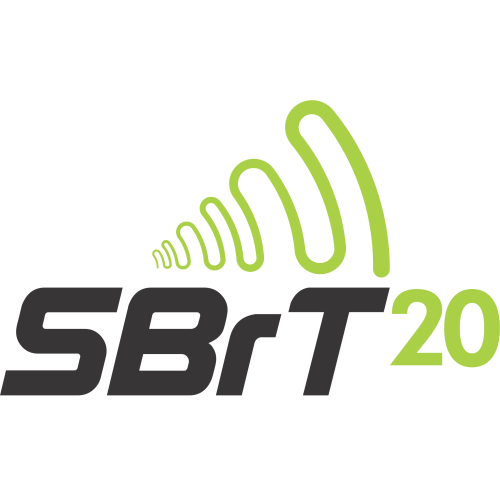
XXXVIII Simpósio Brasileiro de Telecomunicações e Processamento de Sinais
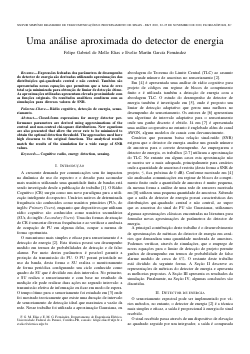
Uma análise aproximada do detector de energia
Felipe G. M. Elias, Evelio M.G. Fernandez
DOI: 10.14209/SBRT.2020.1570654275
Keywords: rádio cognitivo detecção de energia sensoriamento
Abstract
Closed-form expressions for energy detector performance parameters are derived using approximations of the central and non-central chi-square distributions. New equations are also presented that minimize the total error rate to obtain the optimal detection threshold. The approaches used have high closeness to the original functions. The analytical results match the results of the simulation for awide range of SNR values.Download

Sensoriamento Espectral via Modo Adaptativo de Saltos em Frequência do Padrão Bluetooth
Dayan A. Guimarães, Elivander J. T. Pereira, Caroline Pereira
DOI: 10.14209/SBRT.2020.1570654337
Keywords: Bluetooth Rádio cognitivo Sensoriamento espectral Saltos em frequência
Abstract
Na técnica de saltos em frequência adaptativa (adaptive frequency hopping, AFH) do padrão Bluetooth, canais sob interferência são excluídos do padrão de saltos, buscando evitar a queda na qualidade de serviço do sistema. Neste artigo apresenta-se uma prova de conceito de um módulo de sensoriamento espectral de baixo custo e baixa complexidade implementado a partir do modo AFH do Bluetooth, com microcontroladores ESP32. Demonstra-se que a proposta tem potencial de ser explorada para a implementação de sensores de espectro que podem ser conectados a dispositivos da Internet das coisas (Internet of things, IoT), visando ao massivo monitoramento de lacunas espectrais em tempo real de forma a dar suporte à operação de rádios cognitivosDownload
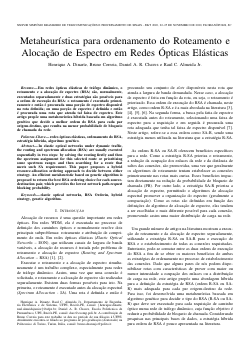
Metaheurística para ordenamento do Roteamento e Alocação de Espectro em Redes Ópticas Elásticas
Henrique A. Dinarte, Bruno Correia, Daniel Chaves, Raul C. Almeida Jr
DOI: 10.14209/SBRT.2020.1570654429
Keywords: redes ópticas elásticas ordenamento do RSA estratégia híbrida algoritmo genético
Abstract
In elastic optical networks under dynamic traffic, the routing and spectrum allocation (RSA) are usually executed sequentially in two steps: by solving the routing firstly and then the spectrum assignment for this selected route or prioritizing some spectrum ranges and then searching for a route that meets such SA requirement. This paper proposes a hybrid resource-allocation ordering approach to decide between either strategy. An efficient metaheuristic based on genetic algorithm is proposed to return the best RSA ordering choice for each source-destination pair, which provides the lowest network path-request blocking probability.Download
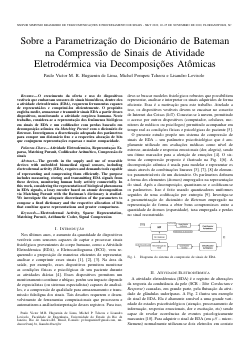
Sobre a Parametrização do Dicionário de Bateman na Compressão de Sinais de Atividade Eletrodérmica via Decomposições Atômicas
Paulo M Lima, Michel Pompeu Tcheou, Lisandro Lovisolo
DOI: 10.14209/SBRT.2020.1570654570
Keywords: Atividade Eletrodérmica Representação Esparsa Matching Pursuit Compressão de Sinais
Abstract
The growth in the supply and use of wearable devices with embedded biomedical signal sensors, including electrodermal activity (EDA), requires and demands tools capable of representing and compressing them efficiently. The purpose includes measuring, storing and transmitting EDA signals from these devices, monitoring human body activity connectedly. In this work, considering the representation of biological phenomena in EDA signals, a lossy encoder based on atomic decomposition via Matching Pursuit with the Bateman's dictionary is studied. We investigate the adequate discretization of the parameters to compose a fixed dictionary and the respective allocation of bits that combine sparse representations and greater compactness.Download
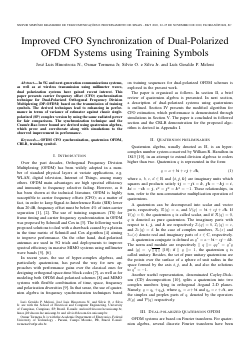
Improved CFO Synchronization of Dual-Polarized OFDM Systems using Training Symbols
José Luis Hinostroza N., Osmar Tormena Jr., Silvio Oliveira e Silva Jr., Luís Geraldo P. Meloni
DOI: 10.14209/SBRT.2020.1570654615
Keywords: OFDM CFO synchronization quaternion OFDM CRLB training symbol
Abstract
In 5G and next-generation communications systems, as well as at wireless transmission using millimeter waves, dual polarization systems have gained recent interest. This paper presents carrier frequency offset (CFO) synchronization technique for Dual-Polarized Orthogonal Frequency Division Multiplex (DP-OFDM) based on the transmission of training symbols. The derived techniques lead to enhancing in performance in terms of variance of estimator against classic single-polarized (SP) complex version by using the same radiated power for fair comparisons. The synchronization technique and the Cramér- Rao lower bound are derived using quaternion algebra, which prove and corroborate along with simulations to the observed improvement in performance.Download
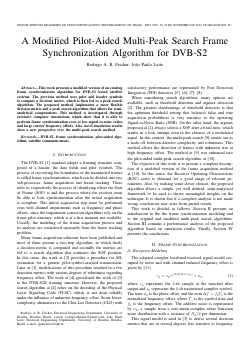
A Modified Pilot-Aided Multi-Peak Search Frame Synchronization Algorithm for DVB-S2
Rodrigo A. R. Fischer, João Paulo Leite
DOI: 10.14209/SBRT.2020.1570654895
Keywords: DVB-S2 frame synchronization pilot-aided algorithm satellite communications
Abstract
This work presents a modified version of an existing frame synchronization algorithm for DVB-S2 based satellite systems. The previous method uses pilot and header symbols to compute a decision metric, which is then fed to a peak search algorithm. The proposed method implements a more flexible decision metric and a peak search algorithm that allows for semi-analytical computations. This method is investigated through extensive computer simulations, which show that it is able to perform frame synchronization even at low signal-to-noise ratios and large carrier frequency offsets. Also, novel simulation results show a new perspective over the multi-peak search method.Download
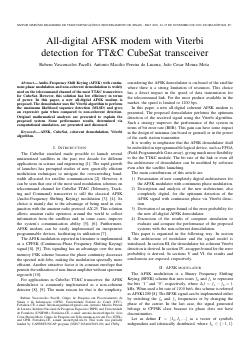
All-digital AFSK modem with Viterbi detection for TT&C CubeSat transceiver
Rubem Vasconcelos Pacelli, Antonio Macilio Pereira de Lucena, Joao Cesar Moura Mota
DOI: 10.14209/SBRT.2020.1570654898
Keywords: AFSK modem Viterbi detector CubeSat transceiver
Abstract
Audio-Frequency Shift Keying (AFSK) with continuous phase modulation and non-coherent demodulation is widely used on the telecommand channel of the most TT&C transceivers for CubeSat. However, this solution has low efficiency in terms of power. In this paper, a new all-digital AFSK modem is proposed. The demodulator uses the Viterbi algorithm to perform the maximum likelihood sequence detection (MLSD) and gives an expressive gain when compared to non-coherent detection. Original mathematical analyzes are presented to explain the proposed system. Some performance results, determined via computational simulation, are presented and discussed.Download
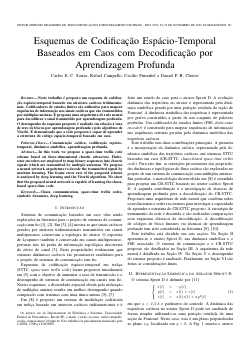
Esquemas de Codificação Espácio-Temporal Baseados em Caos com Decodificação por Aprendizagem Profunda
Carlos Eduardo Souza, Rafael Campello, Cecilio Pimentel, Daniel P B Chaves
DOI: 10.14209/SBRT.2020.1570655166
Keywords: Comunicação caótica Codificação espácio- temporal Dinâmica simbólica Aprendizagem profunda
Abstract
Neste trabalho é proposto um esquema de codificação espácio-temporal baseado em atratores caóticos tridimensionais. Codificadores de estados finitos são utilizados para mapear sequências de informação nos sinais caóticos que são transmitidos por múltiplas antenas. É proposta uma arquitetura de rede neural para decodificar o sinal transmitido por aprendizagem profunda. O desempenho do esquema proposto é avaliado em relação à taxa de erro de blocos por aprendizagem profunda e pelo algoritmo de Viterbi. É demonstrado que a rede proposta é capaz de aprender a estrutura do código espácio-temporal baseado em caos.Download
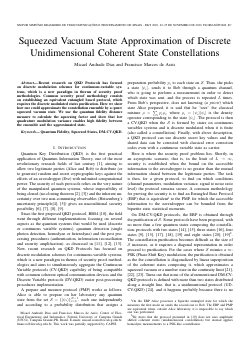
Squeezed Vacuum State Approximation of Discrete Unidimensional Coherent State Constellations
Micael Andrade Dias, Francisco M. de Assis
DOI: 10.14209/SBRT.2020.1570655315
Keywords: Quantum Fidelity Squeezed States DM-CV-QKD
Abstract
Recent research on QKD Protocols has focused on discrete modulation schemes for continuous-variable systems, which is a new paradigm in therms of security proof methodologies. Common security proof methodology consists on establishing an equivalent entangled based protocol, which requires the discrete modulated states purification. Here we show how one could approximate the constellation ensemble by a (pure) squeezed vacuum state. We use the quantum fidelity distance measure to calculate the squeezing factor and show that low quadrature modulation variance enables high fidelity between the ensemble and the approximated state.Download

Sistemas de comunicação baseados em caos com filtros adaptativos kernel e mapa quadrático
Eugênio G. Sabatini, Renato Candido, Magno T. M. Silva, Marcio Eisencraft
DOI: 10.14209/SBRT.2020.1570655325
Keywords: Sinais caóticos filtragem adaptativa baseada em núcleo sistemas de comunicação
Abstract
Kernel adaptive filters are used to solve nonlinear problems, such as the equalization and decoding of chaos-based communication systems (CBCS). This use was investigated in previous works. However, only with CBCS that use bidimensional maps as chaotic signal generators (CSG), which have higher computational cost. In this paper, it is proposed the equalization and decoding by using an unidimensional map as CSG and a kernel adaptive filter as equalizer and decoder. The results show that the use of an unidimensional map leads to a lower bit error rate and computational cost, when compared to the two-dimensional case.Download